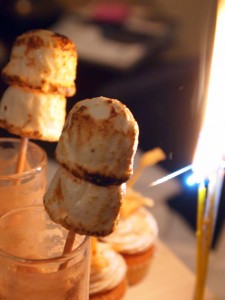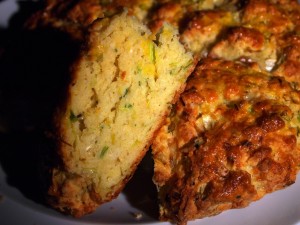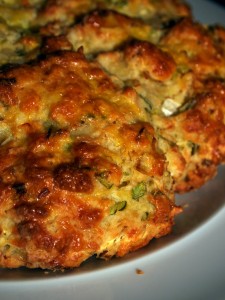I’d been invited back to the Royal Horseguards Hotel (0871 376 9033) in Westminster yesterday to try pastry chef Joanne Todd’s latest bit of afternoon tea whimsy. You might remember the beautiful Wimbledon afternoon tea she confected in the summer, served out on the hotel’s terrace by the Thames. Now the nights are closing in, tea is served by a roaring fire in the hotel lounge, a harpist around the corner belting out oddly incongruous Andrew Lloyd Webber hits.
Joanne’s fast becoming one of my favourite pâtissiers in London. Both of the teas I’ve tried have been well-balanced for sweetness and texture, full of seasonal flavour (elderflower and strawberries in the summer, mulled wine and chestnuts for November), and so full of character, charm and humour that it seems a shame to eat them. Almost. Witness the white chocolate truffles from yesterday’s tea, flavoured with a little chilli and popping candy, and styled to look like a tiny cherry bomb. A shot of hot chocolate, thick with malt, had a couple of marshmallows in it on a stick for toasting – and there was an indoor firework/candle arrangement to toast them on.
“I wanted a really big one that sort of shot flames out of the top,” said Joanne, “but the hotel maintenance people weren’t too happy about the idea.” She looked ruefully at the spotless white ceiling with its architraving, and the handsome soft furnishings and tasselled curtains.
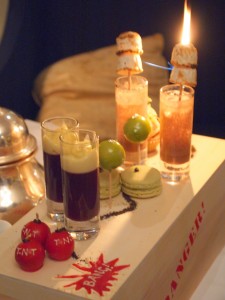
Much as I would have enjoyed a Roman Candle sticking out of my tea, the excellent little sparkling candles more than did the job. Here was a shot of boozy mulled wine jelly with a topping of cinnamon crème pâtissière I could have happily swum in; that most surprising of things, a roast chestnut cupcake where the icing/cake balance was absolutely correct – not too sweet, not too stodgy – with a barking mad but delicious parsnip crisp sticking out of the top; and one of Joanne’s gorgeously toothsome macaroons, this time flavoured with gunpowder tea and decorated with a little nugget of the same.
My favourite were the mini toffee apples. Looking a little like very fat, handsome olives, they were actually a skin of marzipan covered with a sticky, appley glaze. Wrapped up inside was a juicy little spoonful of caramel apple compote – hopelessly good. I could have eaten ten. Lapsang Souchong, being smoked, is the obvious tea to drink with this spread, but you can choose from a large selection of loose teas.
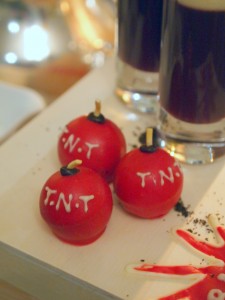
The tea finishes up with a plate of enormous scones (two each), jams and a giant football of clotted cream to anoint them with, and finger sandwiches in good old-fashioned English flavours – cucumber, egg and cress, smoked salmon and ham. If you can’t face the 50-yard waddle to Embankment tube station, they’ll call you a cab. After a tea this size, I don’t think you’re going to be fitting down any Parliamentary tunnels with barrels of gunpowder any time soon.
The Guy Fawkes Afternoon Tea runs until November 7, and costs £28 per person. Joanne has something special up her sleeve for a Christmas tea in December too, and that event will be running all month – book a table while you can!

